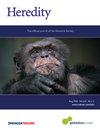Desert landscape features influencing the microgeographic genetic structure of Nelson’s pocket mouse Chaetodipus nelsoni
IF 3.9
2区 生物学
Q2 ECOLOGY
引用次数: 0
Abstract
Elucidating the factors that drive the genetic patterns of natural populations is key in evolutionary biology, ecology and conservation. Hence, it is crucial to understand the role that environmental features play in species genetic diversity and structure. Landscape genetics measures functional connectivity and evaluates the effects of landscape composition, configuration, and heterogeneity on microevolutionary processes. Deserts constitute one of the world’s most widespread biomes and exhibit a striking heterogeneity of microhabitats, yet few landscape genetics studies have been performed with rodents in deserts. We evaluated the relationship between landscape and functional connectivity, at a microgeographic scale, of the Nelson’s pocket mouse Chaetodipus nelsoni in the Mapimí Biosphere Reserve (Chihuahuan desert). We used single-nucleotide polymorphisms and characterized the landscape based on on-site environmental data and from Landsat satellite images. We identified two distinct genetic clusters shaped by elevation, vegetation and soil. High elevation group showed higher connectivity in the elevated zones (1250–1350 m), with scarce vegetation and predominantly rocky soils; whereas that of Low elevation group was at <1200 m, with denser vegetation and sandy soils. These genetic patterns are likely associated with the species’ locomotion type, feeding strategy and building of burrows. Interestingly, we also identified morphological differences, where hind foot size was significantly smaller in individuals from High elevation compared to Low elevation, suggesting the possibility of ecomorphs associated with habitat differences and potential local adaptation processes, which should be explored further. These findings improve our understanding of the genetics and ecology of C. nelsoni and other desert rodents.

影响纳尔逊袋鼠(Chaetodipus nelsoni)微地理遗传结构的沙漠景观特征。
阐明驱动自然种群遗传模式的因素是进化生物学、生态学和自然保护的关键。因此,了解环境特征在物种遗传多样性和结构中所起的作用至关重要。景观遗传学测量功能连接性,评估景观组成、构造和异质性对微观进化过程的影响。沙漠是世界上分布最广的生物群落之一,其微生境具有显著的异质性,但很少有人对沙漠中的啮齿动物进行景观遗传学研究。我们评估了马皮米生物圈保护区(奇瓦瓦沙漠)纳尔逊袋鼠 Chaetodipus nelsoni 在微地理尺度上的景观与功能连通性之间的关系。我们使用了单核苷酸多态性,并根据现场环境数据和 Landsat 卫星图像确定了地貌特征。我们根据海拔、植被和土壤确定了两个不同的基因群。高海拔组在海拔较高(1250-1350 米)、植被稀少、以岩石土壤为主的区域表现出较高的连通性;而低海拔组在海拔较低(1250-1350 米)、植被稀少、以岩石土壤为主的区域表现出较高的连通性。
本文章由计算机程序翻译,如有差异,请以英文原文为准。
求助全文
约1分钟内获得全文
求助全文
来源期刊

Heredity
生物-进化生物学
CiteScore
7.50
自引率
2.60%
发文量
84
审稿时长
4-8 weeks
期刊介绍:
Heredity is the official journal of the Genetics Society. It covers a broad range of topics within the field of genetics and therefore papers must address conceptual or applied issues of interest to the journal''s wide readership
 求助内容:
求助内容: 应助结果提醒方式:
应助结果提醒方式:


